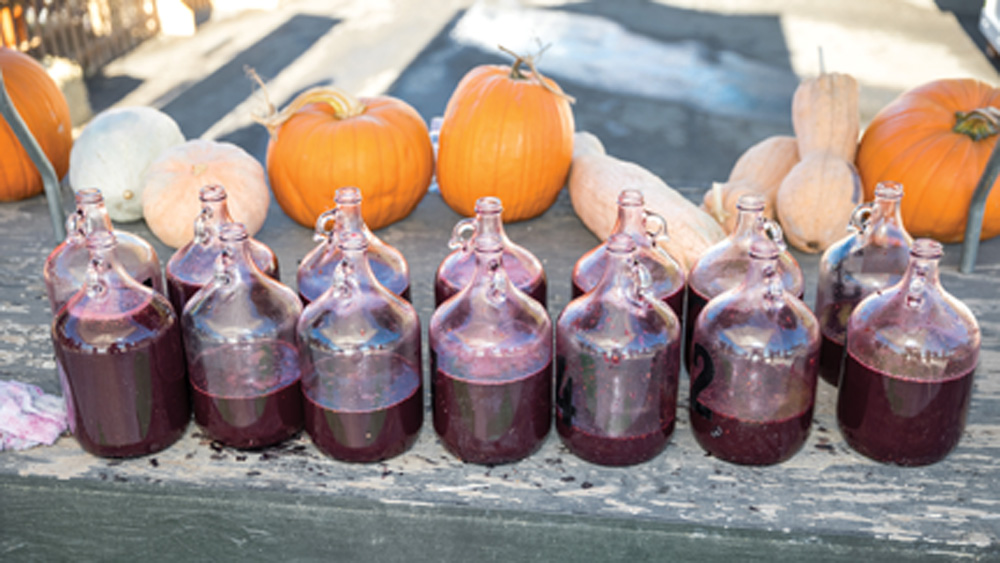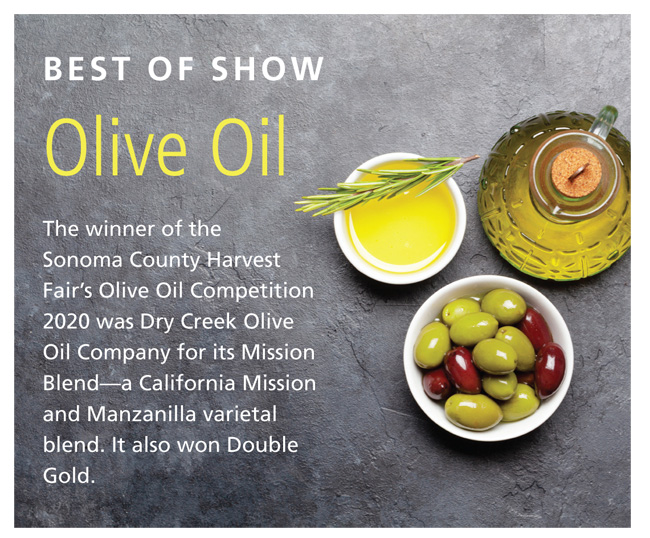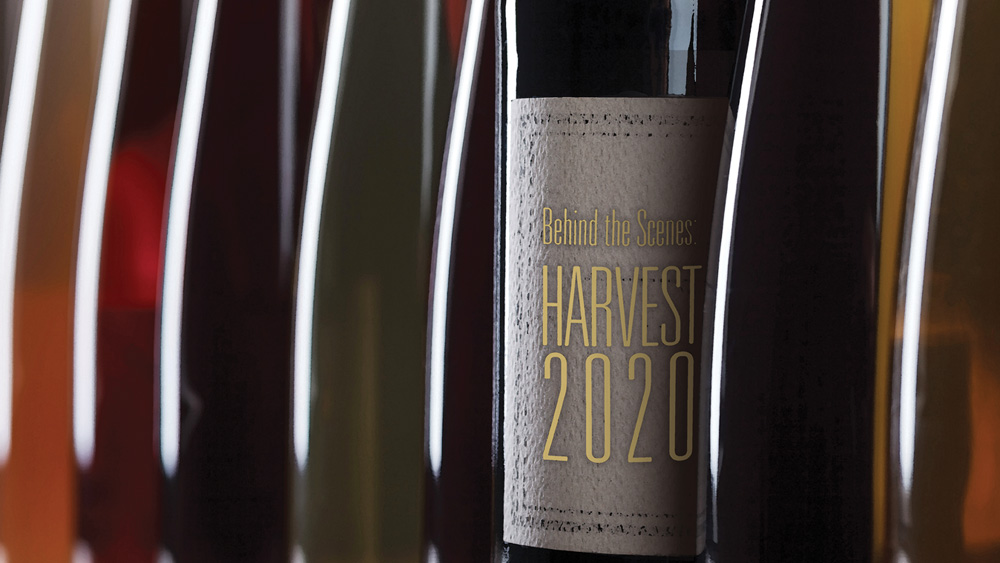
Award-winning wines, innovative culinary creations, freshly harvested grapes for stomping and live music all add to the energy and fun of the Sonoma County Harvest Fair. It’s been an autumn tradition for 46 years, and an event many locals didn’t get to enjoy this year. Most of the activities they’ve come to expect were canceled, falling victim to the coronavirus pandemic, like so many other popular local events.
The fair wasn’t shelved entirely though. Two key Sonoma County Harvest Fair competitions, the Professional Wine Competition and the Professional Food Competition, still took place, allowing the fair to retain two highlights of the harvest season and give Sonoma County’s vintners and other members of the agriculture community a chance to earn recognition for their accomplishments, even if they couldn’t gather to celebrate them.
Wine and food competitions
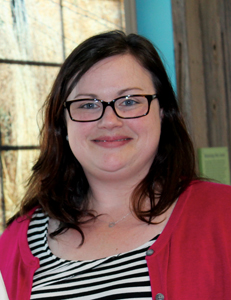
Sonoma County Harvest Fair coordinator Heather Borck explains that the professional wine and food competitions have become the Harvest Fair’s largest components in recent years, so holding them was meaningful, even without public participation. “Knowing that it’s extremely important for our wineries to advertise their products, to help with selling wine in Sonoma County as one our leading industries—or truly the leading industry—it was important to still offer the wine competition this year,” she says.
The annual contest is a valued tradition for winery owners, and they were pleased they could still vie for awards. Some even contacted Borck before the fair announced its decision, to find out if the competition would go ahead. The food competition is a chance for local culinary creators to win awards and showcase their products in much the same way, but the response was mixed as a result of current circumstances. “We have a number of food purveyors who definitely have been struggling through the pandemic,” says Borck. Although they appreciated the fair’s decision to offer the chance to compete, she adds, some regular exhibitors are facing challenges that prevented them from participating. The Amateur Wine and Amateur Brewing Competitions, which give non-professional makers an opportunity to submit their products for judging and get valuable feedback, were put on hold until 2021.
Traditionally, the fair goes into high gear for two event-packed days in the fall, but to accommodate a new reality and implement protocols to keep people involved safe, organizers not only limited the number of contests but spread them out over a lengthier timeframe during the summer.
The Olive Oil Competition came first, in July, and the professional food competition followed in the last week of August and first week of September. The professional wine competition took place in mid-September and winners were officially announced on Sept. 20. Borck explains that the awards announcement is designed to generate enthusiasm for new releases of local wines.
The annual Harvest Fair Awards Night, Ceremony and Celebration is usually a time to party and salute the winners, but it was canceled in response to restrictions on large gatherings as a result of the pandemic. “We’re definitely going to miss our time to celebrate within the industry,” Borck laments. However, she adds, “We are excited about celebrating the wine through the announcement of the awards online and in media releases.”
At a distance
Wine competition coordinator Sheila Quince believes it was more important than ever for the competition to go ahead this year since it’s the largest regional event for local vintners and the only competition some wineries enter. Any wine made with grapes grown in Sonoma County, which has a Sonoma County designated AVA as the only region listed on its label, is eligible, and more than 100 wineries participate, submitting at least 300 wines. “We give any winery a chance to pour wine… Having the wine judged and coming away with a medal is paramount,” says Quince. It’s also an opportunity for members of the wine community to share news about what’s going on locally, she adds, and find out what other vintners are doing.
The fair had to adhere to a strict protocol to make judging possible, but the entry process was much the same as previous years for the wineries. They aren’t present for the judging under normal conditions, so the most significant changes were in the procedure for evaluating wine, which required using the correct protocol and implementing safety measures to allow judging on-site. She reports that other competitions had already done this successfully, and the Harvest Fair was able to benefit from their experience. In addition, she volunteered to assist at other competitions beforehand, so she had an opportunity to observe how the protocol worked and learn how to implement it.
Sommelier Debra Del Fiorentino, wine educator, founder and president of Wine Competitions Management & Productions, wrote the protocol that Sonoma Health Services Department approved for use at competitions in the county, and she spent two months going back and forth to develop a set of guidelines that would ensure the safety of judges, staff and volunteers and thus allow judging. She gives credit to Debbie Townsend of the Sonoma County Fair for her help. “She is familiar with the folks at the health department and she greatly assisted in my maneuvering through all of their hurdles,” says Del Fiorentino, who also served as a judge at the Harvest Fair.
Entries closed on Aug. 21, and the wineries delivered their submissions in early September, giving volunteers time to stage the wines and assign identifiers in preparation for the competition, which took place on Mon., Sept. 14, and Tues., Sept. 15, and Wed., Sept. 16. The safety measures began with a handwashing station outside the 4,090-square-foot Showcase Café, which was the location of the competitions. Markers outside the doors designated spacing required for social distancing, and people had their temperature taken before they were allowed to enter the building. In addition, everyone had to wear a mask.
In previous competitions, three judges sat together at a table and constituted a panel of experts who judged a specific number of wines. This year, however, they were in three individual judging pods six feet apart. “We’ve got the space. There’s lots of room to allow space,” says Quince. Volunteers, who wore masks and gloves the entire time, delivered the wines to the judges, following a one-way traffic pattern in and out of the judging space to avoid any cross traffic. They had to take one route to get into the building to set up a flight and another to exit and reach a back room so they could pick up and take out the next flight. The crew that pours wine usually cleans up after the judges have finished a tasting. This year, however, the judges put their own glasses into a rack that a volunteer took to the kitchen so the glasses could be washed. “Individuals who pour the wine never handle a wine glass that’s been touched by a judge,” says Quince. They stepped back from their pods so a volunteer team could set up the next flight and took their seats again when they were ready to start work on evaluating a new wine.
During the first stage of judging, the judges discuss an entry after they have tasted it, and each gives it a placing—gold, silver or bronze. If all three judges are unanimous in giving a wine a gold, it receives a double gold. If one judge gives it a lower ranking, it gets a single gold. After the judges have tasted all the wines and completed their evaluations, they taste the top winners again and vote to select a Sweepstakes winner for each category. Other than safety measures, the judging remained much the same, with a masked moderator recording the results of every judging and a description of each wine.
One of the goals of the competition is to reach other areas and give Sonoma wines national exposure. To achieve a wide geographic reach, the Harvest Fair invites retailers, restaurateurs, oenologists and educators from throughout the country to serve as judges. The result is a diverse panel both geographically and in areas of expertise that’s representative of the United States, with judges from other states such as Florida, New York and Texas. That, however, wasn’t possible this time, and Quince reports that nobody who required airfare was invited. “Most of them said they wouldn’t have come anyway. It made complete sense,” she says. Sommeliers and writers from the Los Angeles area often participate as well, but they declined. As a result, all of the judges were either local or from Sacramento and the Bay Area—within driving distance. “There is so much talent right here, we don’t have to go anywhere else,” she observes. She adds that the Harvest Fair sends a list of award winners to other regions, so the outcome was much the same as any other year, with judges evaluating wine and the Harvest Fair spreading the good news about Sonoma County wines as far and wide as possible.
For the wineries, having the competition in a year when business has been far from usual was invaluable. Sharon Cohn, cofounder of Breathless Wines in Healdsburg with her sisters Rebecca and Cynthia Faust, observes that it was a chance to let the world know that Sonoma County wineries are open; growers were harvesting grapes; and vintners were banding together to showcase their wines. Thus, even though it might have been reinvented, the competition was still able to shine a spotlight on the best of the best in Sonoma County.
Missing pieces
While the wine competition provided important benefits, some aspects couldn’t be replaced. Among the losses were the opportunity for staff members to see old friends and the vitality that people enjoying a traditional event add to the fair. “It’s the energy of stepping into a room of so many smiling faces. People are learning about wine and enjoying the event,” says Quince. In addition, some of the judges have become her friends, and she looks forward to reconnecting with them, but up-close contact wasn’t possible.
For Borck, one of losses was in being unable to interact with people the way she usually does. “Not seeing the individuals we see each year,” she says, explaining that vintners had to submit their entries online instead of walking into the office with their forms and taking time to stop and chat. The fair is a celebration of local agriculture as well as food and wine. “It’s the people in Sonoma County agriculture who make the Harvest Fair so special.”

While the professional wine competition took place this year, the Tasting Pavilion, a related event for the public where representatives of the industry pour glasses of wine, did not. Thus, fairgoers missed the chance to get excited about tasting new releases and learning about wine at a major event. It was a loss for the wineries too. Cohn finds the pavilion a fun way to connect with people who already know about Breathless Wines, as well as those who are discovering its wines for the first time and might visit the tasting room later to learn more.
For the vintners, the Harvest Fair Awards Night, Reception, Ceremony & Dinner the weekend before the fair, is an industry event that brings the agricultural community together to hear the winners of the competitions and agriculture awards announced. “I love the dinner and camaraderie,” says Cohn, explaining that it’s a chance to dress up, share her best wines and mingle with friends at an annual get-together everyone enjoys. They know how hard everyone has worked all year, and the celebration is also a way of acknowledging each other’s efforts. It didn’t happen this year, with restrictions on large gatherings in place, but for Cohn, it brings back memories. “We entered Breathless before it was actually released in 2013 and gave it a kiss for good luck,” she says. They were astonished to discover they’d won the Sweepstakes award for specialty wines. “It was so surprising to become the Sweepstakes winner but shouldn’t have been with [winemaker] Penny Gadd-Coster at the helm.”
Looking ahead
The 47th annual Sonoma County Harvest Fair is already on the calendar for 2021, and hopes are high that activities will return to normal. The fair is in transition, however, and has changed substantially since it began in 1975. “That big event that we remember from years ago, the model has changed,” says Borck, explaining that the fair is a nonprofit, and expenses exceeded revenues, forcing a change in the model. Formerly a three-day fair, it’s now two, and instead of variety of autumn events, its focus has narrowed to concentrate on food and wine.
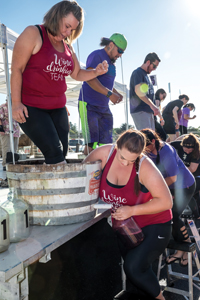
In 2019, the Harvest Fair and the Sonoma County Fair, which takes place in the summer, started to discuss merging the two events. “It turned out not to be an issue, as it wasn’t possible to hold a fair this year as a result of COVID-19,” says Kaitlyn Findley-Thorn, chief operating officer at the Sonoma County Event Center, which hosts both fairs.
While there were discussions about merging the two events, the decision has since been made that the public tasting of the Harvest Fair will take place as a stand-alone event in 2021, as it has in the past. A merger would have had logistical challenges. “We’ve weighed the pros and cons,” she says. “While it was discussed, the public tasting will continue as it has in the past. Discussions continue regarding how the Harvest Fair may be able to partner with the Sonoma County Fair in celebrating the region’s agriculture during the annual event.”
Meanwhile, hopes are high for 2021. The local recognition, participating in a local event and being part of the community scene are rewarding for participants, Gadd-Coster observes, and one way or another, the show will go on.
The fair was limited to just two competitions in 2020, but the natural cycle of the seasons continues for vintners. “The rhythm of the harvest, the celebration of the old wines and the beginning of the new is always fun. And in today’s world, those memories wrap you up in a happy cocoon and make you feel that everything is going to be alright,” says Cohn. It’s an optimistic view, as Sonoma County waits for a return to normalcy and anticipates good times ahead.
